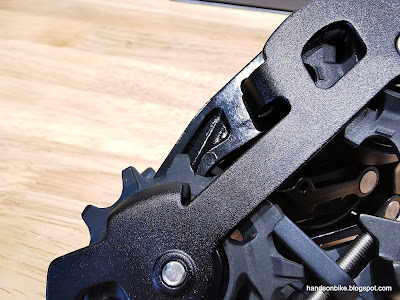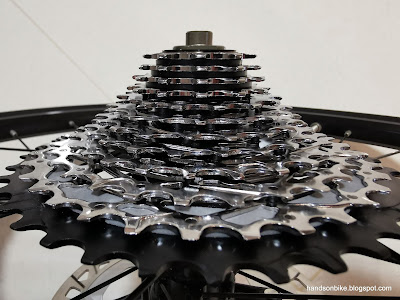The key component to the SRAM AXS 12 speed drivetrain on the Fnhon folding bike is the rear derailleur. It needs to communicate wirelessly with the shifter, and also shift the chain across the 12 speed cassette. The rear derailleur is the most expensive part of the groupset, as it has many electronics and mechanical components in it.
I chose the SRAM Force AXS, instead of Red or Rival. The Red version is just too expensive, and it has similar features as the Force, except being a little bit lighter due to some carbon parts. On the other hand, the Rival version is a little cheaper and heavier, which is actually a good choice as well. However, the Rival version did not have the Orbit fluid clutch, which I wanted to try.
Comes in a big box!
Way too much empty space in the packaging. This box size might be used for another component, which is why it is so big.
Force logo can be seen clearly on the shiny outer link.
I was surprised to see such a big bulk in the middle of the parallelogram! Apparently this is where the motor and gears are located.
Rear derailleur does not come with an eTap battery, which is sold separately.
The battery will be attached to the rear of the rear derailleur.
At the front, we see the function button and also the LED indicator. This area is pretty bulky as well due to the fluid clutch.
This is a relatively short cage version for road and gravel usage.
Aluminium cage plates
Tall teeth guide pulley, without narrow wide teeth.
Tension pulley actually has narrow wide teeth, to match the chain.
Both the top and low limit screws will touch the aluminum inner link.
This is the Force Wide version, compatible with 36T sprocket, for gravel usage.
Parting lines from injection molding can be seen clearly here, not so ideal for appearance.
The cage goes very close to the mechanism, everything is packed tightly together.
Without battery, the rear derailleur weighs 303 grams.
Here is the battery!
Attaching the battery is very simple, just slot it in and use the latch to lock it in place.
Including battery, the derailleur is 327 grams. The battery itself weighs 24 grams.
Once the battery is attached, and paired to the shifter, the rear derailleur can be operated wirelessly!
How it looks when shifted to the lowest gear. The way the bulky mechanism tucks into the parallelogram is quite clever, since a big tension spring is no longer occupying the space.
A wire links the battery to the motor unit, across the parallelogram.
There is a small spring inside, to eliminate looseness from the parallelogram.
Another view of the wire.
So far so good, the rear derailleur is able to shift normally after pairing with the shifter. It is the first time I am using or studying the SRAM AXS rear derailleur, so there are many new things for me to learn.
An equivalent rear derailleur from Shimano would be the GRX RD-RX815, which is also a gravel rear derailleur, compatible with front double systems, and comes with a clutch. It is a little bit lighter in weight, but otherwise quite similar in terms of function.




























































